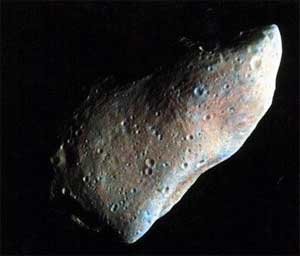Astronomers have recently warned of an asteroid that could potentially collide with Earth in 2102. However, this risk may decrease with ongoing further studies.
 |
|
The asteroid 951 Gaspra, measuring 19 km in length, was the first asteroid observed up close by the Galileo spacecraft on October 29, 1991. |
2004 VD17 was first detected by experts from the Massachusetts Institute of Technology. New observations have helped researchers to calculate its orbit with greater accuracy. Specifically, 2004 VD17 has the potential to collide with Earth on May 4, 2102.
It is estimated that 2004 VD17 has a diameter of about 580 meters. An asteroid of this size could create a crater approximately 10 km wide and cause an earthquake of 7.4 on the Richter scale if it were to strike land. According to Don Yeomans, Director of NASA’s Near-Earth Object Program, the collision risk for 2004 VD17 is ranked at level 2 on the Torino Scale.
The Torino Scale, adopted in 1999, is similar to a Richter scale for impacts between Earth and asteroids. Level 1 (blue) suggests that a collision could occur and warrants close monitoring. As the levels increase beyond 1, the risk continues to escalate. Levels 2, 3, and 4 are yellow. Levels 7 are orange, and levels 8, 9, and 10 are red.
In December 2004, the asteroid Apophis was rated at level 4—the highest level an asteroid has achieved to date. However, subsequent calculations lowered the risk to level 1. This is why 2004 VD17 currently holds the top position on NASA’s list of potential collisions.
Yeomans indicated that the collision risk for 2004 VD17 is 1 in 1,600 for 2102 and 1 in 500,000 two years later. Nevertheless, further observations are expected to provide a more precise orbit and hopefully reduce the collision risk to zero.
According to Andrea Milani Comparetti, a near-Earth asteroid hunter from the University of Pisa, Italy, 2004 VD17 is a serious concern, but not for our generation. VD17 is quite faint and distant, thus requiring powerful telescopes to observe it before it approaches.
Since 1998, NASA has been tasked by the U.S. Congress with identifying 90% of all near-Earth asteroids measuring 1 km or larger. This mission was set to be completed by 2008.
To date, NASA has identified 830 of approximately 1,100 such asteroids, along with thousands of smaller celestial bodies.
According to the NASA Authorization Act passed in 2005, Congress mandated NASA to study and report on the best and most efficient ways to identify 90% of asteroids with a minimum diameter of 140 meters. Yeomans estimates that there are about 100,000 such asteroids.
Minh Sơn

















































